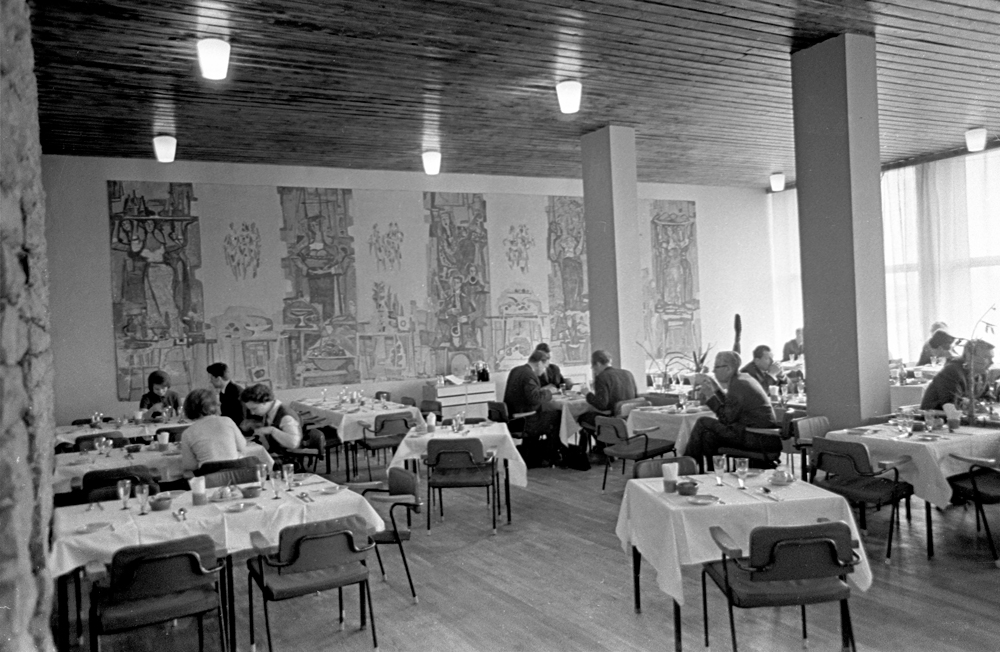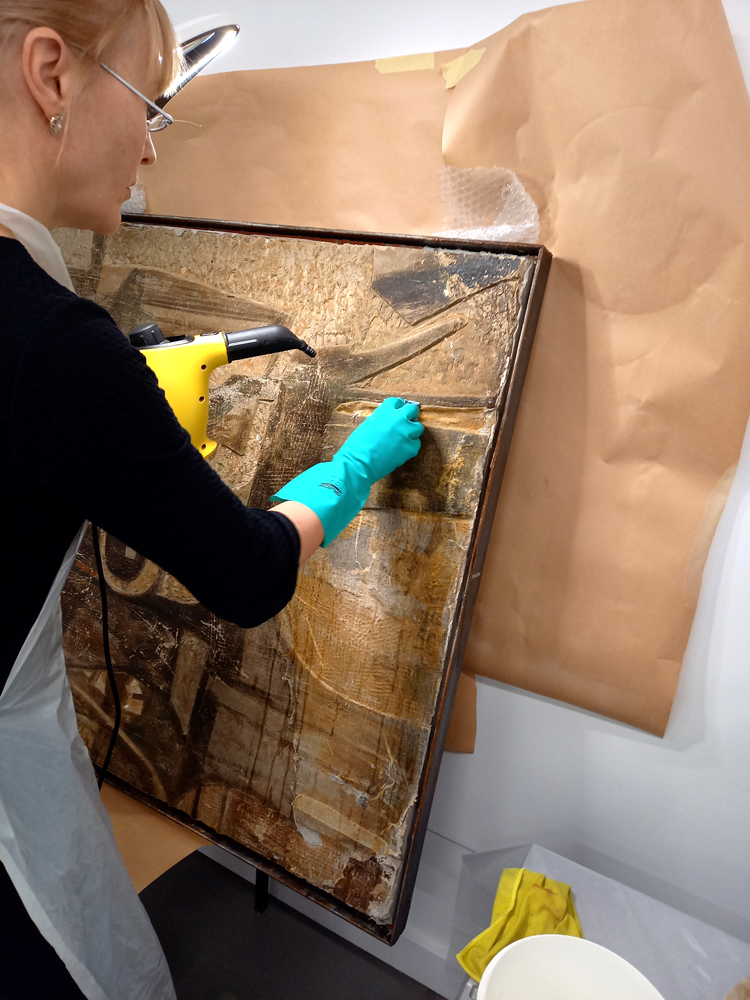Elmar Kits. Restaurant Tarvas wall panel (1965)
On display from November 14, 2025, on B-sideSgraffito, 260 × 900 cm
Estonian National Museum, ERM K 5399/1–9
Elmar Kits (1913–1972) was one of the most outstanding Estonian modernist painters – an artist who managed to stay true to his ideals of painting even under ideological pressure, and who, in moments of liberation, became an innovative and powerful creator. The legacy of Elmar Kits is invaluable, both for the artistic quality of his works as well as for his role as a bearer of free creative spirit.
Writing about Kits’ artwork, the newspaper Edasi (24 December 1965) said that, for the first time he gave form to the newly opened building ensemble in Tartu. The most significant of these artworks was the monumental sgraffito mural created for the Tarvas restaurant, one of the first and boldest examples of modernist art in postwar Estonia’s public space. Technically masterful and expressively rhythmic in its play of light and dark, the mural radiated vitality and abundance. It is considered one of Kits’ masterpieces; upon its completion some remarked said “perhaps this is too good for a tavern”.
For decades, the Tarvas restaurant mural was familiar to many Tartu residents to the point where it was part of the city’s social and cultural life. However, expectations for buildings change over time, and in autumn 2013, the mural was removed from the building as it was slated for demolition. For protection gauze and cotton fabric were glued on with rabbit-skin glue. Grooves were then cut into the wall to insert a metal frame, which in turn was covered with plywood panels. The space between the plywood and the fabric was filled with mounting foam. Afterwards, the wall was sawn through behind the metal frame and the mural was taken down. The back was reinforced with plaster mesh and self-levelling compound. (https://digiteek.artun.ee/static/files/079/demonteerimine.pdf) This method was used in Estonia for the first time. The mural was disassembled in the hope that it would soon be installed in the newly built Kvartal shopping centre, but plans changed and the mural panels were donated to the Estonian National Museum (ERM).
For years, the mural panels were stored along the wall of a corridor in ERM’s wood storage facility until the curator of the Kellele kuulub öö (Who Owns the Night?) exhibition expressed the wish to display the central panel. At the curator’s request – and with the encouragement and guidance of Hilkka Hiiop, who led the disassembly process – the so-called ‘unpacking’ of the central panel began. It became clear during this process that the mural’s condition was poor: the sgraffito plaster layer had largely detached from the underlying wall plaster and required thorough stabilisation. The same was assumed for the other panels.
Work began at the end of 2023 with the opening of the fifth panel, which became a pilot project for the restoration of the entire series. Based on the experience gained, all the panels were conserved over the next two years. The conservation process included the following steps:
- self-tapping screws were removed from the plywood panels;
- plywood panels and metal frames were cut free of the mounting foam and removed;
- the mounting foam was removed from the mural surface, leaving it only in recesses;
- the mural panel was placed face down on a stable, smooth surface;
- the loose back layer of wall plaster was removed, leaving only the plaster layer applied by the artist for the sgraffito;
- cracks in the plaster were filled with Ledan D1 injection mortar, and larger voids with a marble lime plaster mix tinted with earth pigments;
- the entire plaster layer was treated with a deep penetrating primer;
- metal frames were cleaned of foam and fitted with larger mounting holes;
- a new support base was prepared by joining two Tulppa boards, drilled for pull nuts (covered with masking tape to keep out the plaster mix);
- the mural’s plaster layer was surrounded with a frame, filled with tiling compound, embedded with plaster mesh, and topped with the support board; weights were applied and it was left to dry for two weeks;
- the metal frame was placed onto the support board and secured with bolts, then the panel was lifted off the base;
- mounting foam was removed from the sgraffito recesses;
- the fabric and glue layers were removed from the mural’s surface using hot water and a steam sprayer.
Now the mural is once again whole and stable and on display to the public to be seen and admired and its future reflected upon. Estonia’s artistic heritage is worth saving and caring for.
Thanks to everyone who contributed!
Interior view of the Tarvas Restaurant. Photo: Viktor Salmre, 1966–1967. ERM Fk 2644:5196

Disassembly of the mural

Detachment of the plaster layer

Removable layers

Removal of mounting foam

Part of the gauze has been removed

Removal of the fabric



